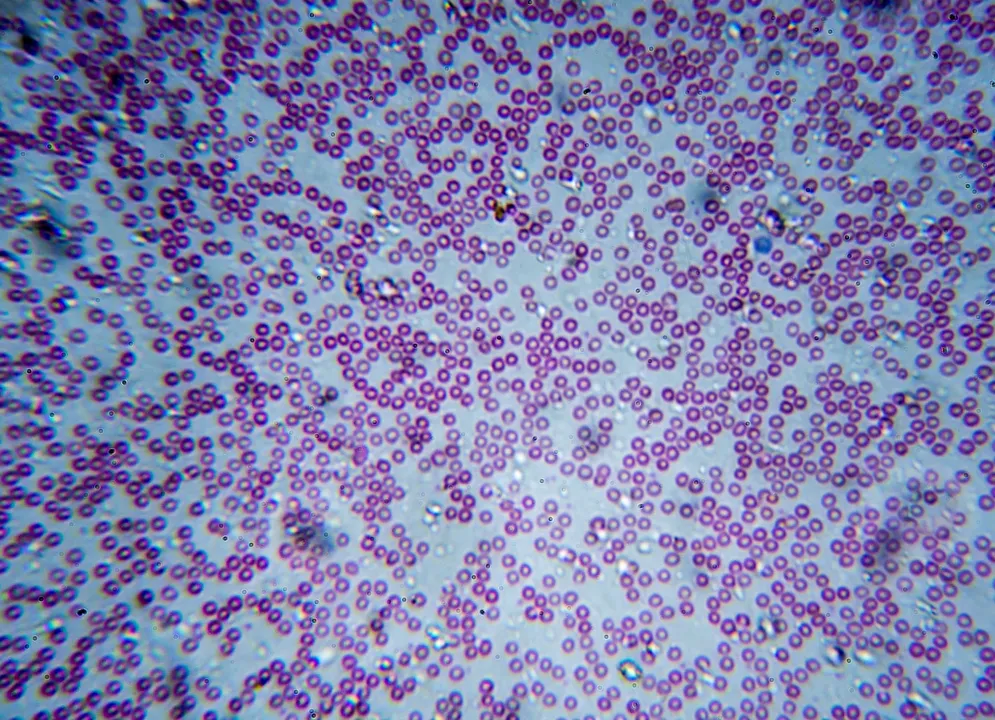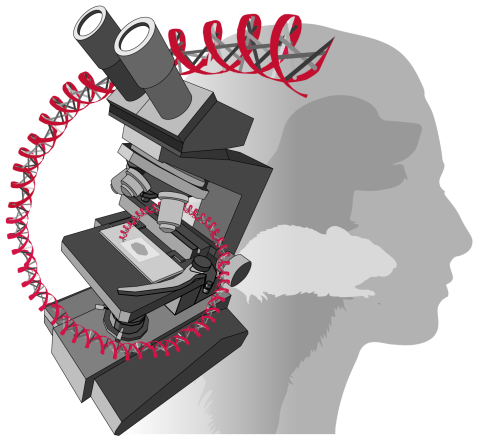Histology and Immunohistochemistry
The CPDISR Histology Laboratory is housed in the Department of Veterinary Biosciences in the College of Veterinary Medicine and offers routine and advanced histology and immunohistochemistry services, supporting the diagnostic needs of the Veterinary Medical Center as well as the needs of research investigators campus wide. The Histology Laboratory is managed and staffed by five histotechnologists, certified by the American Society for Clinical Pathology, with extensive experience in routine histochemical, immunohistochemical and immunoflourescent techniques.
The lab prides itself on generating rapid turn-around of the highest quality histologically prepared animal tissue specimens. The Histology lab staff possesses considerable experience with a wide range of animal models and specimen types including ocular and orthopedic tissue. Immunohistochemical staining techniques are optimized for animal tissue; a particular area of emphasis is the development of immunohistochemical staining techniques suitable for mouse tissues. New staining protocols are added periodically, so please contact us for a current list of available protocols and markers.

Routine Histology Services
The Histology / IHC Lab offers a high degree of flexibility with the pathologists and research investigators that it serves. The lab accepts routine histology requests as well as specialized studies to facilitate the needs of clinicians and researchers throughout the OSU campus and beyond. Below is a list of the most common services and special staining techniques that the lab performs. Click on individual stains for a detailed description of each. Please call the lab at any time to see how we can assist you with your next project. All services requests are performed electronically through our online submission system eRAMP which is interfaced to eREQUEST.
Proficiency and Feedback
The Histology/Immunohistochemistry Core participates in quarterly proficiency testing for our histology/immunohistochemistry technicians. Quality of microtomy and routine histochemical and immunohistochemical stains is assessed through the HistoQIP Program and the College of American Pathologists.
Please direct feedback on slide preparation and staining to the CPDISR Director, Dr. Kara Corps.
Available Services
- Tissue trimming
- Tissue processing
- Tissue embedding
- Microtomy
- Routine Hematoxylin & Eosin staining
- Routine special staining
- Frozen sectioning
- Consultation
- Ocular specialization
- Orthopedic specialization
- Advanced special staining
- Tissue MicroArray
Immunohistochemistry

The Immunohistochemistry Program within the CPDISR Histology Laboratory offers a variety of IHC stains that have been optimized for veterinary use to provide optimum staining results that are free from non-specific background staining. The lab's IHC service is offered at excellent pricing for both diagnostic and research purposes. Please see our current list of offered antibodies here (link to current IHC list).
One of our core services is the Validation and Optimization of new antibodies for research and diagnostic purposes. Our experienced IHC tech and a board-certified comparative pathologist will consult on antibody selection and proper control tissues, followed by comprehensive validation of the selected antibody and optimization of an IHC labeling protocol. Please contact our IHC tech or the CPDISR Director for additional information.
Notes
- In order to achieve optimal staining results, it is critical that specimens are fixed in the appropriate volume of 10% Neutral Buffered Formalin for at least 24 hours (in exception to staining protocols requiring fresh, unfixed, frozen samples).
- Where possible, we have selected antibodies that detect the same antigen in multiple species. However, not every antibody works well in all species, and some antibodies are appropriate for use in only a single species. To determine if a specific antibody is appropriate for your intended use, please contact CPDISR 614-247-8122 or CPDISR@osu.edu
Special Histochemical Stain Guide
Interested in your special stain results? Request Slide Evaluations with one of our board-certified comparative pathologists!
Gram
- Gram-positive organisms—blue to blue-violet
- Gram negative organisms—red
- Background—yellow
Giemsa
- Bacteria—blue
- Nuclei—blue
- Cytoplasm—pale blue
- Rickettsias—reddish purple
- Erythrocytes—yellowish pink
Ziehl-Neelsen
- Acid-fast bacteria—bright red
- Other tissue elements—according to counterstain (blue or yellow)
Fites
- Atypical mycobacteria—bright red
- Other tissue elements—blue
Warthin Starry
- Bacteria (spirochetes, helicobacter)—black
- Background—pale yellow to tan
Steiner
- Bacteria (spirochetes, legionella)—black
- Background—pale yellow
Gimenez
- Chlamydia—red
- Background—green
PAS (Periodic Acid-Schiff's)
- Simple polysaccharides, neutral mucosubstances, basement membranes, mucolipids and fungus—magenta
- Background—according to counterstain
Alcian-Blue
- Sulfated mucosubstances—blue
- Background—according to counterstain
GMS (Grocott Methenamine-Silver)
- Fungi—sharply delineated in black
- Pneumocystis—black
- Mucin—dark gray to black
- Background—green
Wilder's Reticulum
Reticulum fibers—black
Background—pale pink
Gordon-Sweet
Reticulin—black
Background—according to counterstain
Masson's Trichrome
- Nuclei—black
- Cytoplasm, muscle, keratin—red
- Collagen—according to counterstain (blue or green)
Jones'
- Reticular fibers and basement membranes—black
- Other tissue elements—according to counterstain
PTAH
- Nuclei—blue
- Cytoplasm—blue
- Collagen—brown-pink
- Fibrin—blue
- Elastic fibers—purple
- Striated muscle fibers—blue
- Neuronal and glial cell processes—blue-purple
Verhoeff's Elastic
- Elastic fibers—black
- Nuclei—blue to black
- Collagen—red
- Other tissue elements—yellow
Rhodanine
- Copper—red yellow
- Nuclei—light blue
Von Kossa
- Calcium deposits—black
- Background—pink
Perl's Iron (Prussian Blue)
- Iron deposits—brilliant blue
- Background—pink
PAS (Periodic Acid-Schiff's)
- Simple polysaccharides, neutral mucosubstances, basement membranes, mucolipids and fungus—magenta
- Background—according to counterstain
Alcian-Blue
- Sulfated mucosubstances—blue
- Background—according to counterstain
Congo Red
- Amyloid deposits—pink to red
- Note: Amyloid will show an apple-green birefringence when polarized
Nuclei—blue
Cresyl Echt Violet
- Nissl substance—blue
Bielschowsky's
- Axons—black
- Intracellular neurofibrils—black
Luxol Fast Blue
- Myelin sheath—blue-green
- Background—according to counterstain
PTAH - Nuclei—blue
- Cytoplasm—blue
- Collagen—brown-pink
- Fibrin—blue
- Elastic fibers—purple
- Striated muscle fibers—blue
- Neuronal and glial cell processes—blue-purple
Osmium
- Lipid—black
OFG (Pituitary)
- Acidophils—orange-yellow
- Basophils—magenta-red
- Chromophobes—pale green
- RBS's—yellow
Churukian Schenk
- Argyrophil and argentaffin cells—black
- Nuclei—orange to red
- Background—light yellow
Toluidine Blue
- Mast cells—deep reddish purple
- Background—faint blue
Contact Information
The CPDISR Histology Lab is located at 302 Goss Laboratory, 1925 Coffey Road.
Kara Corps, DVM, PhD
Lab Director
Phone: 614-292-4261
Email: corps.2@osu.edu
Routine and Special Histochemical Services
Johanna Rawlings
Histotechnician
Phone: 614-292-3327
Email: rawlings.58@osu.edu
Immunohistochemistry Services
Kevin Thorburn, PhD
Immunohistochemistry
Phone: 614-292-3327
Email: thorburn.10@osu.edu